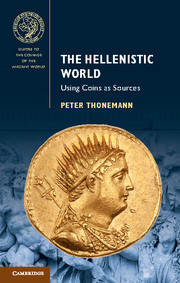7 - Bronze and silver
from Part III - Political economy
Published online by Cambridge University Press: 05 December 2015
Summary
From silver to bronze
So far, this book has concentrated on big, flashy precious-metal coinages: silver tetradrachms, gold staters and other large-denomination issues. But this gives a very misleading impression of how coinage was actually used on a day-to-day basis in ordinary Hellenistic towns and villages. Tetradrachms and staters were the equivalent of £50 notes or $100 bills – handy for making large payments, but not so useful for buying a loaf of bread. Most low-level exchange was instead conducted with bronze coins.
Token bronze coins – that is to say, coins made of cheap metal, assigned a ‘token’ value by the issuing authority – were first introduced on a large scale in the Greek world in the late fifth and early fourth century BC (Ashton 2006; Konuk 2011; Grandjean and Moustaka 2013). In a culture which assumed that money should be worth its weight in precious metal, this splendid innovation was at first met with suspicion. During the last years of the Peloponnesian War, in the face of a desperate silver shortage, Athens struck a token bronze coinage with a thin silver plating (Fig. 7.1). In his play Frogs, Aristophanes gives vivid expression to the Athenians’ disgust at being reduced to this ‘wretched bronze’ (ponēra chalkia), ‘the vilest coinage ever’ (Frogs 718–33; Kroll 1976). Nonetheless, by the mid-fourth century BC, bronze coins were in widespread use throughout the Greek world for small, everyday transactions. By the later Hellenistic period, many cities were operating with four or even five different denominations of bronze coinage (Ashton 2012b: 201–2).
An inscription from the small city of Gortyn on Crete illustrates how a community might go about introducing a bronze coinage for the first time. Around 250 BC, the Gortynians decided to stop using small-denomination silver coins (silver obols, worth one-sixth of a drachm) and moved over to a token bronze coinage, apparently with the same face-value as the earlier obols (Figs. 7.2–7.3; Jackson 1971).
- Type
- Chapter
- Information
- The Hellenistic WorldUsing Coins as Sources, pp. 128 - 142Publisher: Cambridge University PressPrint publication year: 2016

